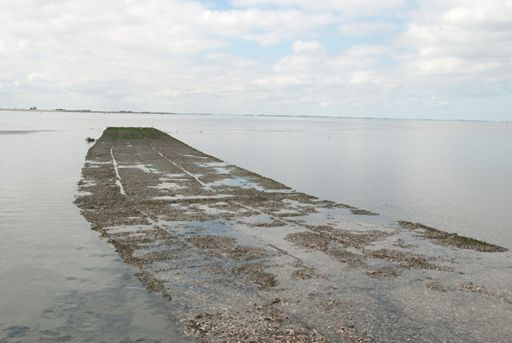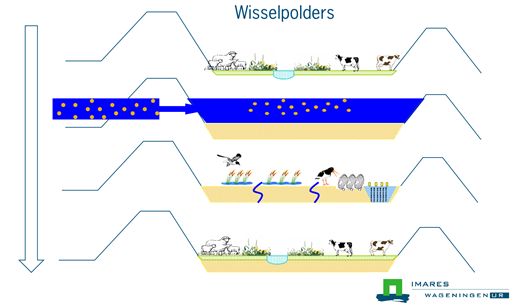Building with Nature in coastal defence
Purpose of the tool
The Building with Nature concept aimes at using ecological processes in shaping deltas and coastal zones. Organisms like mangrove trees, seagrass, mussels and oysters can collect sediment and thereby help to strengthen the coastal defence mechanisms, create optimal conditions for food production, and increase natural values.
Target group
Governmental agencies like national and regional governments, water boards, environmental NGO’s, companies involved in nature conservation.
Tool description
Ecosystem engineers are plants or animals that influence their environment with their presence or activities. Ecosystem engineers fit well within the Building with Nature philosophy because they can be used to stabilize and protect shorelines and intertidal habitats against erosion and thereby minimize wave attack on the coast without undermining ecological processes. Many ecosystems are greatly affected by ecosystem engineering, such as coastal salt marshes, where plants trap sediment (sand or clay particles) by reducing hydrodynamic energy. Other examples of ecosystem engineers are reed marshes, willow tidal forests, mangroves, seagrass beds, coral reefs and bivalve reefs (oysters or mussels).
The Building with Nature concept can contribute to ecological applications such as restoration and ecosystem management. In recent years the interest in using ecosystem engineers in coastal defence has grown. Especially the ecosystem engineering properties of reducing wave energy and trapping sediments make species such as reef building oysters and salt marsh plants interesting target species. The use of ecosystem engineers in coastal management can contribute to a more sustainable, cost-effective way of protecting our coasts, especially in the light of climate change and sea level rise. Secondly, there is a need for methods of coastal protection that incorporate the natural dynamics and processes of the ecosystem, allowing a more resilient and robust future coastline. This way the many ecosystem services that coastal habitats in general and ecosystem engineers in particular provide can be safeguarded.
Result description
The use of ecosystem engineers is illustrated with two examples:
- Pilot oysterreefs in the Oosterschelde bay in the Netherlands
- The concept of 'Wisselpolders'
The tool in practice
1. Pilot Oysterreefs
In the Oosterschelde in the Southwest Delta in the Netherlands a large scale pilot is in progress which studies and evaluates the use of Pacific Oyster (Crassostrea gigas) reefs in reducing the erosion of the intertidal zone. In addition to reduction of wave energy it focuses on the role of these reefs in the stabilisation of tidal flat edges. The pilot is executed within the Building with Nature innovation programme and conducted by collaborating parties IMARES Wageningen UR, Rijkswaterstaat, NIOZ and Deltares. Oyster reefs are placed at two locations: near the dike and on the outer tidal flat on the south side of eastern Schouwen-Duivenland. This pilot started in 2009 and is still running.

2. Concept of 'Wisselpolders'
The concept of Wisselpolders aimes at developing low-lying coastal areas into more robust and elevated coastal zones while utilizing the area for aquaculture and agriculture. Low-lying polders are often prone to salt intrusion and therefore unsuitable for crops that require freshwater. Sea level rise and land subsidence will worsen this effect. By breaching the primary dike the polder will be subject to tidal influence and sedimentation. A second line of defence (old dike) will protect the land behind from flooding. With every tide, sediment is deposited onto the polder and the area will gradually elevate. In the meantime the area can be utilized for aquaculture e.g. saline crops and (shell)fish culture. After 10-30 years the elevated area can be reclaimed again and used for agriculture.

Necessary input and conditions
Realisation of these tools requires knowledge of ecological processes and locations with suitable conditions for implementation.
Contact data
Organisation: IMARES
Marijn Tangelder
Korringaweg 5, Yerseke
0317-487540
Marijn.tangelder@wur.nl
www.imares.nl
Phase and tool category: Implementation | Pilots and experiment proven technologies
Spatial scale and time scale
Ecosystem engineers can be implemented world-wide in deltas and coastal regions.
Spatial scales ranges from small patches to ecosystem level; time scale years to decades.
Tool availability
- In the pilots more knowledge and experience is gained on using ecosystem engineers in coastal protection.
- Pilot Oysterreefs Oosterschelde (Dutch)
- Oysterreefs and coastal defence and food production in Bangladesh (English)
Downloads
- Building with Nature (English)
- Wisselpolders (Dutch)
- Ecosystem engineers in the Southwest Delta (Dutch)
- Ecosystem engineers in the Wadden Sea (Dutch)